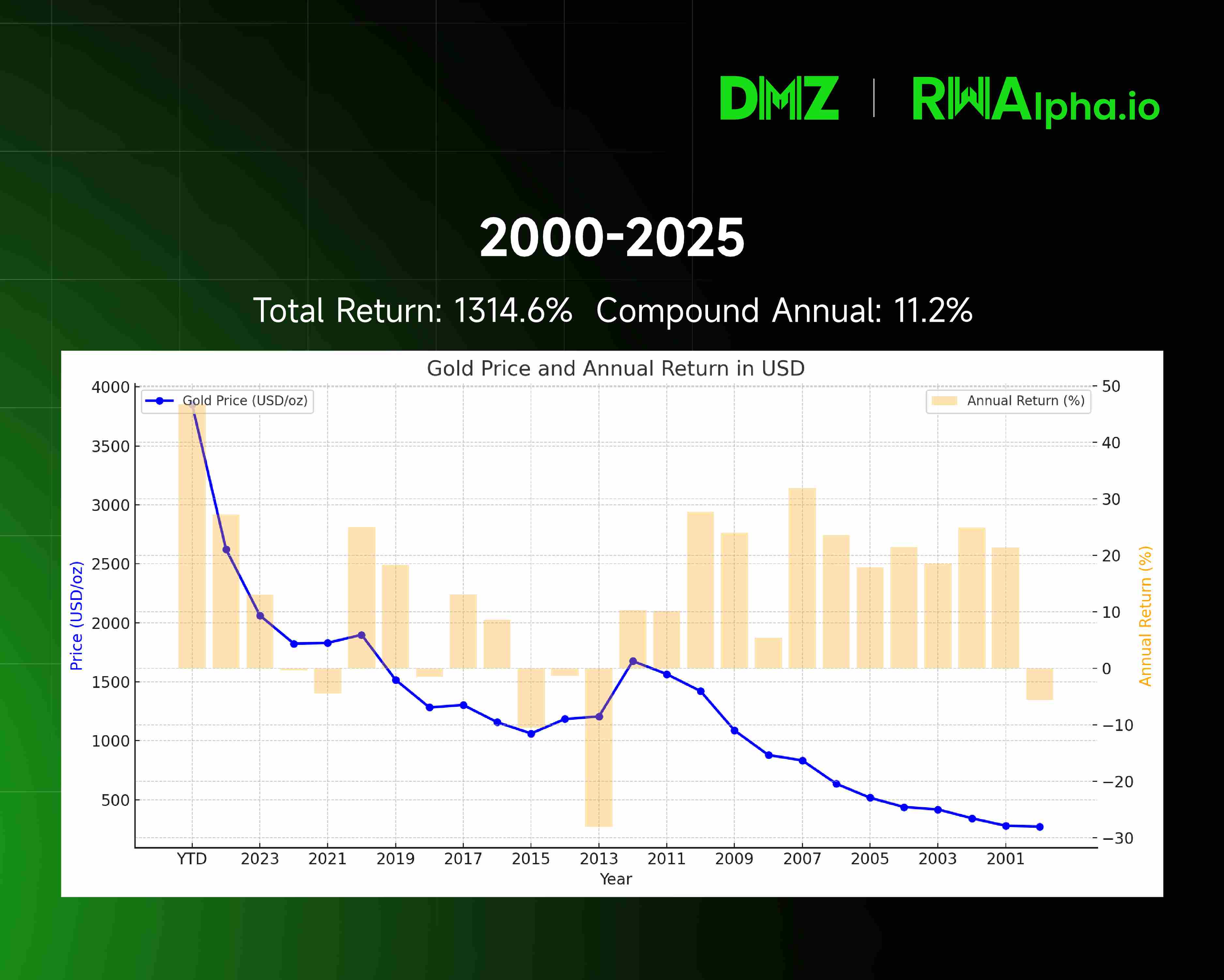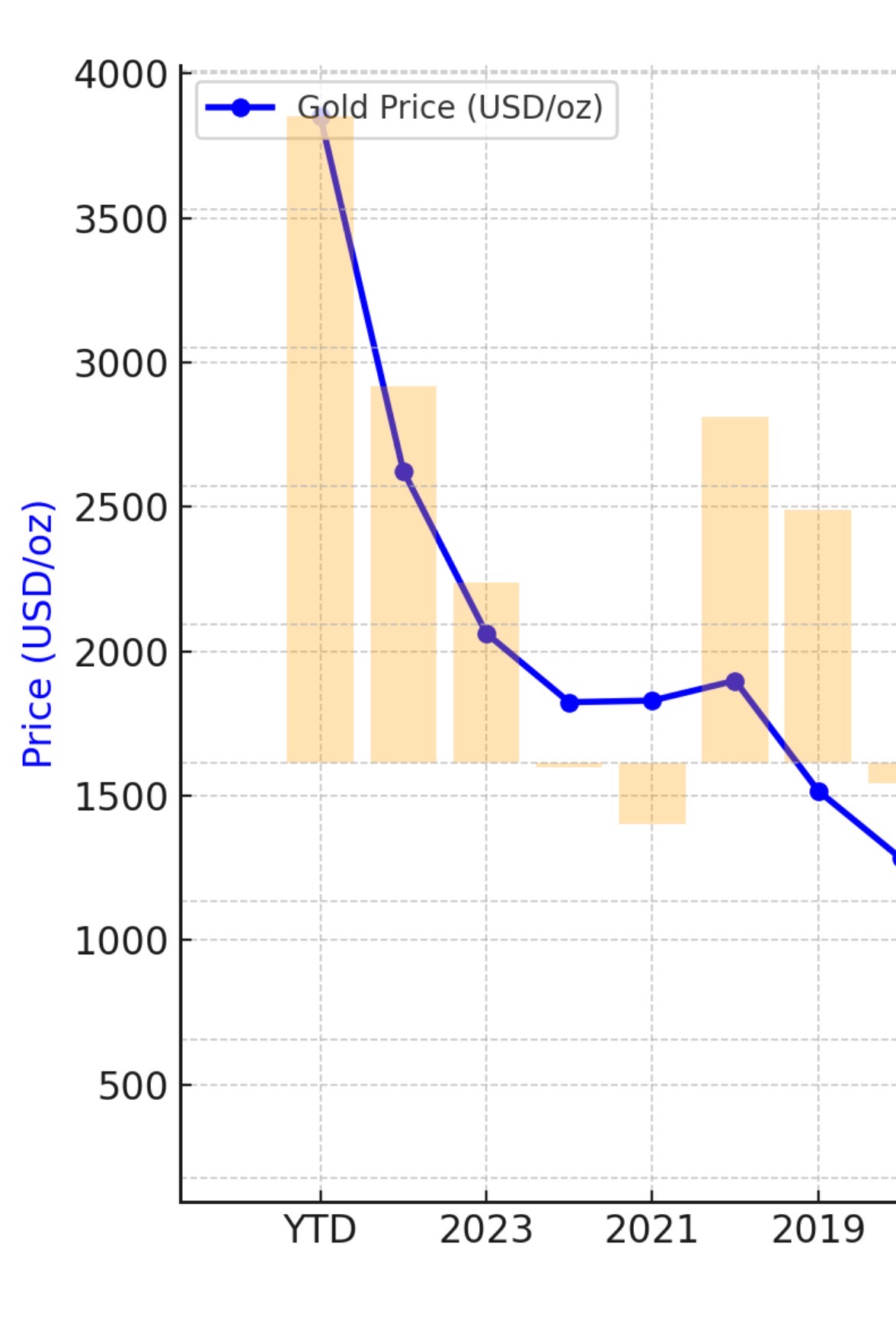Seize the historic opportunity.
Written by: Nathan Ma, Co-founder of DMZ Finance
When the price of gold breaks through $4,000 per ounce in 2025, many will realize: this asset, once considered "conservative," is experiencing a stunning surge.

Gold Price Trends and Annual Returns from 2001 to 2025. A review of historical data shows a clear upward trajectory for gold.

Accelerated Gold Price Uptrend from 2019 to 2025
Focusing on data starting from 2019, it is not difficult to see that the compound annual growth rate from $1,500 in 2019 to $4,000 in 2025 exceeds 18%, far surpassing most traditional asset classes.
This surge is not coincidental, but rather the inevitable result of four core factors working together.
1. 2019 - Institutional Reform: Basel III Redefines the Value of Gold
The turning point for gold's fate began with an international banking regulatory document known as "Basel III."
This regulatory framework, introduced after the 2008 financial crisis, was fully implemented in major economies around 2019. Its core objective is clear: to ensure that banks hold enough high-quality capital to withstand risks. Under this new regulation, the status of gold underwent a fundamental change.
In the old regulatory framework, gold was classified as a "Tier 3 asset"—holding gold required banks to incur expensive capital costs. This ancient metal became a burden in the modern financial system.
However, Basel III made a revolutionary decision: it officially set the risk weight of physical gold to zero. This means that in banks' risk assessments, gold now stands alongside cash and top-tier sovereign debt.
This change directly reduced the cost of holding gold for banks, prompting them to include gold in their high-quality liquid asset portfolios. Gold returned to the center of the financial system, laying the institutional foundation for subsequent price increases.
2. 2022 - Russia-Ukraine War: The De-dollarization Wave Triggered by $300 Billion in Frozen Assets
If Basel III paved the way for gold's rise in 2019, the Russia-Ukraine war in 2022 directly ignited the engine.
Approximately $300 billion of Russia's foreign exchange reserves were frozen, allowing the world to witness another form of "credit" collapse—sovereign-backed bonds and deposits could vanish overnight in the face of political risk.
This event prompted central banks worldwide to reassess the safety of reserve assets. According to data from the International Monetary Fund, the dollar's share of global foreign exchange reserves has dropped from 72% in 2000 to 58% in 2025, marking a nearly thirty-year low. Meanwhile, over 20% of central banks indicated in 2024 that they would continue to increase their gold holdings in the next two years.
This trend is evident globally. The Reserve Bank of India increased its gold holdings by over 200 tons between 2023 and 2025, raising its gold reserve ratio to 8%; the National Bank of Poland added about 130 tons during the same period, stating that "geopolitical risk is a key factor in the decision to increase holdings"; the Monetary Authority of Singapore also announced in 2024 that it would raise its gold reserves by 15% to enhance the resilience of the financial system.
These actions by central banks signify that the world is undergoing a profound restructuring of reserve assets. As sovereign credit risks become apparent, gold, which requires no counterparty commitment, is becoming the inevitable choice for central banks in the new geopolitical environment.
3. Three Years of Pandemic - Monetary Overexpansion: Continuous Dilution of Dollar Purchasing Power
The surge in gold prices also reflects the dilution of purchasing power of fiat currencies, especially the dollar.
Theoretically, as a scarce physical asset, gold can serve as a store of value against inflation to some extent. When governments issue large amounts of currency leading to a decline in purchasing power, gold, due to its inherent scarcity, can be priced in more monetary units.
During the three years of the pandemic, major global central banks implemented unprecedented monetary easing policies. The Federal Reserve's balance sheet expanded sharply from about $4 trillion in early 2020 to nearly $9 trillion at its peak in 2022, an increase of over 125%. Meanwhile, the M2 money supply in the U.S. surged from $15 trillion to $21 trillion between 2020 and 2022, an increase of over 40%, marking the fastest monetary growth since World War II.
Historically, while gold's performance in combating inflation has not always been effective, it has indeed played a significant role during specific periods. Throughout the 1970s, the U.S. suffered from "stagflation," with an average annual CPI increase of 7.1%. During this time, the price of gold soared from about $35 per ounce in 1970 to a peak of about $670 per ounce in 1980, an increase of over 1,800%.
From 2021 to 2023, supply chain bottlenecks and large-scale fiscal stimulus following the COVID-19 pandemic drove global inflation higher. The U.S. CPI reached a 40-year high of 9.1% in June 2022. Although the rapid interest rate hikes by the Federal Reserve put pressure on gold prices, the high inflation environment still provided significant support for gold.
Data shows that since 2000, the real purchasing power of the dollar has declined by about 40%. This long-term value dilution has forced investors seeking to preserve value to look for alternatives outside of dollar credit.
4. China’s Asset Reallocation - Reserve Reconstruction: Strategic Adjustments by Global Central Banks
China's foreign exchange reserve management strategy is becoming an important variable influencing the gold market.
Compared to the end of 2019, China's foreign reserve structure shows a clear trend of "reducing debt and increasing gold": holdings of U.S. Treasuries decreased from $1.0699 trillion to $0.7307 trillion (as of July 2025), a net reduction of $339.2 billion, a decline of -31.7%; while official gold reserves increased from 1,948 tons to 2,303.5 tons (as of September 2025), a net increase of 355 tons, an increase of +18.2%. This reduction and increase reflect the deep strategic considerations of the People's Bank of China.
China's foreign exchange reserves are vast, but behind this large reserve is a structural change in asset allocation—moderately reducing U.S. Treasury holdings while steadily increasing gold.
As of the end of September 2025, gold accounted for only 7.7% of China's official international reserve assets, significantly lower than the global average level of around 15%. This indicates that the People's Bank of China still has ample room to continue increasing its gold holdings in the future.
This trend is not unique to China. According to the World Gold Council, the global central bank gold buying spree has continued to rise since setting a historical record in 2022 (1,136 tons). The market generally expects that the net gold purchases by central banks will remain above 1,000 tons for the fifth consecutive year in 2026, a historical high. Russia has transformed from a net exporter to a net importer of gold since 2006, with gold reserves continuously increasing.
The surge in gold purchases by central banks is driven by profound strategic considerations: gold, as a widely accepted ultimate means of payment, can enhance the credibility of sovereign currencies and create favorable conditions for advancing currency internationalization.
5. Future Outlook: The Logical Support for Gold to Continue Increasing Tenfold in the Next 10-15 Years
Based on the current fundamental analysis, achieving a tenfold increase in gold over the next 10-15 years is not a pipe dream. This judgment is based on the following core logic:
First, the global central bank "de-dollarization" process has just begun. Currently, the dollar still accounts for nearly 60% of global foreign exchange reserves, while gold accounts for only about 15%. If this ratio achieves rebalancing in the next decade, the demand for gold purchases by central banks alone will bring trillions of dollars into the gold market.
Second, the continuous expansion of global money supply contrasts sharply with the limited growth of gold stock. Over the past twenty years, the M2 money supply in major global economies has increased nearly fivefold, while the annual growth rate of gold reserves has been less than 2%. This supply-demand imbalance will continue to support rising gold prices in the long term.
Third, the normalization of geopolitical risks will continue to highlight gold's safe-haven attributes. In a transitional period where dollar credit is impaired and emerging reserve currencies are not yet mature, the value of gold as a neutral reserve asset will be further reassessed.
Conclusion: Seize the historic opportunity
The surge in gold prices is not driven by a single factor, but rather the result of the combined effects of "institutional reform, geopolitical factors, monetary overexpansion, and reserve reconstruction."
Looking ahead, many institutions, including Goldman Sachs, hold an optimistic outlook on gold prices, with Goldman Sachs even raising its gold price forecast for December 2026 to $4,900 per ounce.
"Gold is money; everything else is just credit." In today's context, where the value of credit currencies is under scrutiny, gold provides a wealth guarantee that has stood the test of time. Only configurations that allow for a sound sleep are the true confidence to traverse cycles.
免责声明:本文章仅代表作者个人观点,不代表本平台的立场和观点。本文章仅供信息分享,不构成对任何人的任何投资建议。用户与作者之间的任何争议,与本平台无关。如网页中刊载的文章或图片涉及侵权,请提供相关的权利证明和身份证明发送邮件到support@aicoin.com,本平台相关工作人员将会进行核查。




